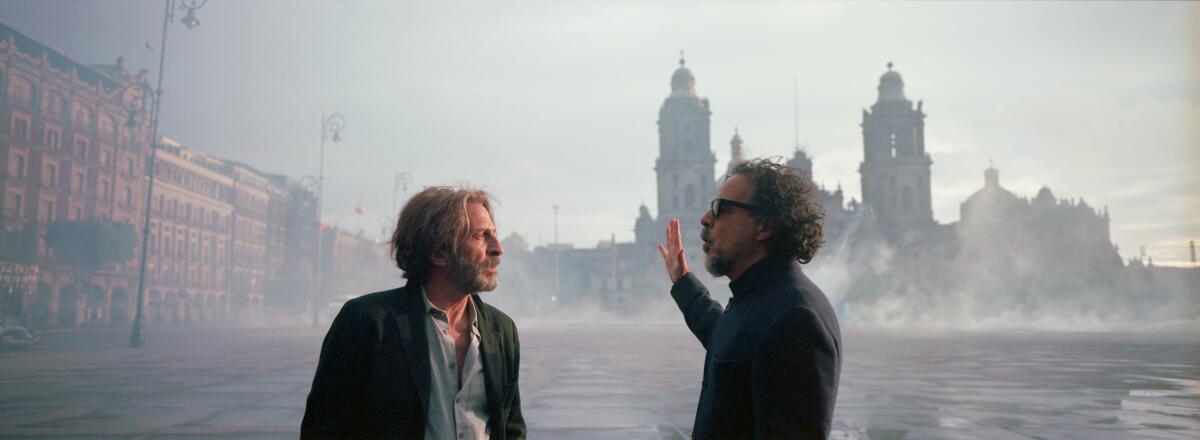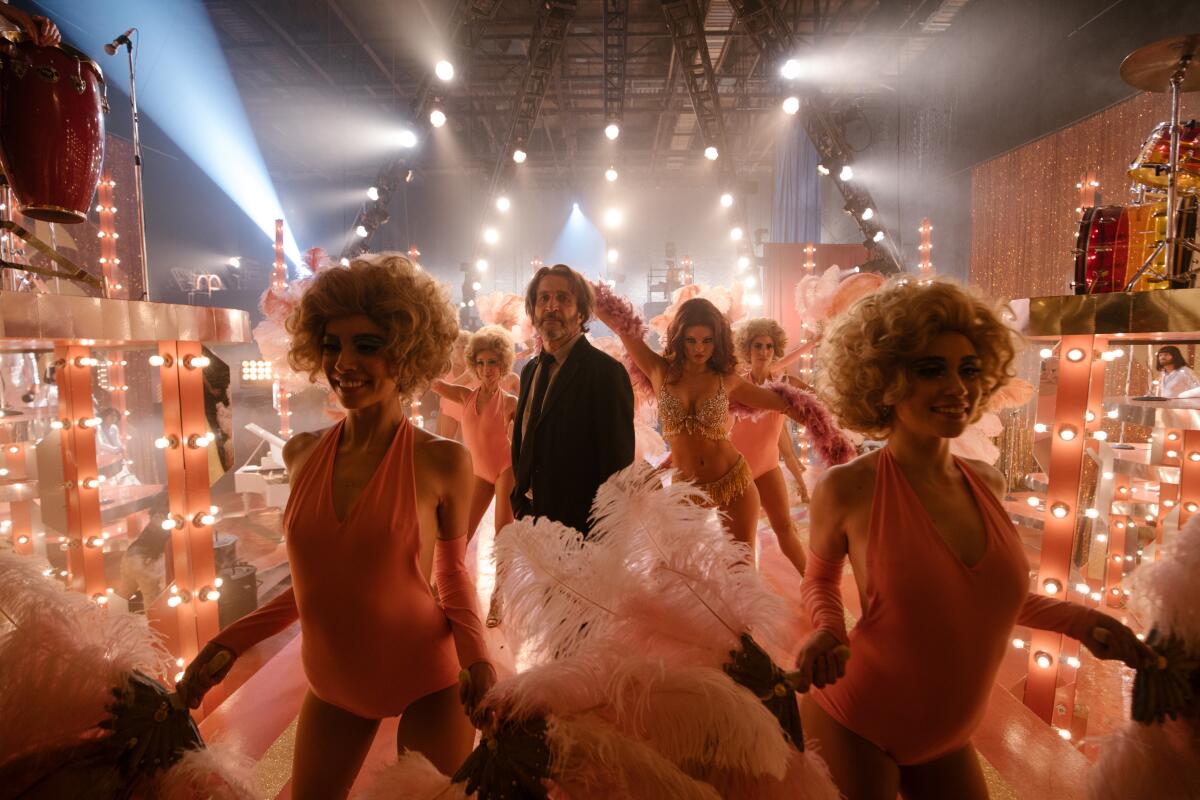A critic takes a second look at Alejandro G. Iñárritu’s ‘Bardo’ — and is thankful he did

It’s no surprise — perhaps it was even inevitable — that one of the more widely criticized scenes in “Bardo, False Chronicle of a Handful of Truths,” Alejandro G. Iñárritu’s magnificent and maddening new movie, would feature an artist confronting his most outspoken critic.
The artist — and the movie’s protagonist — is Silverio Gama (Daniel Giménez Cacho), an acclaimed journalist and documentary filmmaker making a return trip to Mexico several years after moving to Los Angeles. The critic, whom he runs into at a party, is Luis (Francisco Rubio), a TV personality who has made Silverio a regular punching bag on his talk show. Predictably, Luis is no fan of Silverio’s latest work, dismissing it as “pretentious,” “a mishmash of pointless scenes” that “lacks poetic inspiration.” But for him, Silverio’s gravest artistic crime is not his self-indulgence or his betrayal of his Mexican roots but rather his coyness, the way he hides his true self behind teasing metafictional layers: “If you want to talk about your life,” Luis says, “tell it straight.”
For your safety
The Times is committed to reviewing theatrical film releases during the COVID-19 pandemic. Because moviegoing carries risks during this time, we remind readers to follow health and safety guidelines as outlined by the CDC and local health officials.
That could well be a dig at the predictably divisive, relentlessly zigzagging “Bardo” itself, a semi-autobiographical fantasia that blurs the line where Silverio’s life ends and Iñárritu’s begins. The movie (which the director co-wrote with Nicolás Giacobone) is a carnivalesque romp through time and memory, one that owes something to the labyrinthine magic realism of Jorge Luis Borges and something to the jaunty surrealism of Federico Fellini. Iñárritu and his cinematographer, Darius Khondji, send their camera floating across sun-drenched sands and barreling down corridors of consciousness, collapsing barriers between history and hallucination, comedy and drama, life and death, Silverio and Alejandro. For both men, the movie — Iñárritu’s first to shoot primarily in Mexico since his 2000 debut feature, “Amores Perros” — marks a rare homecoming, a return marked by joy and nostalgia, but also ambivalence and frustration.

One of the questions that “Bardo” leaves you with is whether Iñárritu, after years of enviable Hollywood success, now feels estranged from the country he left behind. You may also wonder if, the Luises of the world aside, Silverio’s career has generated anything like the public scorn that Iñárritu’s often has. That may seem like an odd thing to say about a filmmaker who’s long had his partisans, but in truth, the violent critical rejection of Iñárritu in some circles is the kind that can only befall an already much-acclaimed, industry-lionized artist. And as someone who’s gone up and down with Iñárritu over the years and felt alternately defensive and disdainful of his work, it feels fitting — in the face of his most nakedly personal work and his most openly combative salvo to his critics — to lay some of that baggage on the table.
In an artistic medium often driven by the talent and personality of the auteur, more than a few critics keep a running inventory of their favorite and least favorite filmmakers and, within those individual catalogs, their favorite and least favorite of their efforts. And for more than a few Iñárritu dissenters, his best film remains his first. An electrifying triptych of stories brought together by crashing cars, fiery passions, bestial men and yapping, snapping dogs, “Amores Perros” turned heads and stomachs with its ferocious violence but generated enough acclaim to become the first Mexican production in 25 years to earn an Oscar nomination for best foreign-language films. It also introduced the world to a magnetic newcomer named Gael García Bernal and established Iñárritu and his screenwriter, Guillermo Arriaga, as deft storytellers with a feel for gritty lower-depths realism and a Tarantinoid touch for splintered narratives.
Those qualities persisted — and more Oscar nominations followed — with their grimmer-than-grim “21 Grams” (2003), another jaggedly melodramatic pileup starring a mesmerizing Sean Penn, Naomi Watts and Benicio Del Toro, and with “Babel” (2006), an uneven tapestry of sob stories stretching from the dusty mountains of Morocco to the strobe-lit nightclubs of Tokyo. To revisit these first three features, with their incremental shift in focus from Mexico to the U.S. to the entire world, is to grasp the full scale of Iñárritu’s outsized ambitions. But what looked like ambition to some began to reek of arrogance to many others, who were increasingly turned off by what they saw as the showy miserablism and gimmicky grandiosity of his filmmaking.

As a lover of “21 Grams” and a qualified admirer of “Babel,” I’ve always felt a little protective of this early phase of Iñárritu’s career; for all their obvious manipulations and missteps, these two movies achieve, for me, a bruising emotional power that little of his work has approximated since. I’ve also suspected that Arriaga was more than a little crucial to their success, something that seemed all the more apparent after writer and director parted ways (under less-than-amicable circumstances) and Iñárritu struck out with “Biutiful” (2010), a dour slog that not even Javier Bardem’s excellent performance could save.
“Biutiful” earned Iñárritu the worst reviews of his career and may well have provoked him into spewing some of the anti-critic sentiments in his 2014 comeback, “Birdman or (The Unexpected Virtue of Ignorance),” a bravura Broadway satire starring Michael Keaton as Riggan Thomson, a washed-up actor mounting a comeback of his own. It also marked a radical stylistic break; after working for years with director of photography Rodrigo Prieto, Iñárritu found, in Emmanuel Lubezki, a cinematographer whose flowing, beautifully choreographed long takes could achieve a breathtaking new unity of form. Rather than chopping his scenes into jangly bits (though he retained the same editor, the versatile Stephen Mirrione), Iñárritu pursued a new visual coherence; rather than dividing his attention among a swath of far-flung characters, he unfolded an entire drama — in a foreshadowing of “Bardo” — within one man’s restless, self-flagellating consciousness.
“A thing is a thing, not what is said of that thing,” reads a postcard on Riggan’s dressing-room mirror. I flashed back on that line — and the memorable scene in which Riggan butts heads with a New York Times theater critic (Lindsay Duncan) — when I first watched “Bardo” months ago and came across that party confrontation scene. This time, though, Iñárritu wasn’t just casually thumbing his nose; he seemed to be trying to preempt criticism and to show that he can enjoy a laugh at his expense, provided that he controls the source and duration of the laughter. He also seemed keen to give his media detractors a taste of their own spiteful medicine. And so Silverio dismisses Luis as little more than “an entertainer, an opinion peddler” who scrounges for likes on social media. Ouch! “It’s people like you who have left us without truth,” Silverio declares, right before hitting a mute button that magically silences Luis’ rebuttal.

Iñárritu, it’s easy to imagine, must fantasize about muting his own persecutors in the press. At the same time — and this is where “Bardo’s” animus takes on a productively playful edge — you have to wonder why, if so, he keeps giving them such a prominent voice and point of view in his work. Is he constructing some kind of infernal artist-critic ouroboros, laying a clever trap for us and watching as we take the bait (to paraphrase some metaphors he floated in a tetchy recent interview with my Times colleague Josh Rottenberg)? Or is he, by lowering himself to the presumably rock-bottom level of his detractors, essentially tumbling into his own trap?
I don’t know. It’s possible the man just can’t help himself. Maybe he felt that swiping at critics actually paid off with “Birdman,” ironically the movie restored Iñárritu to a lot of reviewers’ good graces. Not all of us, though: I found it funny, inventive and dazzling, if also thin, overdetermined and more than a little taken with its own virtuosity. Still, it couldn’t help but feel refreshing after Iñárritu’s earlier marathon of misery; it handily won the Academy Award for best picture and earned Iñárritu his first Oscar for directing. He would win another the following year for his dark neo-western “The Revenant” (2015), a return with a vengeance to bleak, violent terrain that struck me as a staggeringly emotionless experience, Iñárritu’s emptiest display of directorial chest-beating yet.
As of this writing, the academy seems unlikely to shower “Bardo” with similar accolades, for which we can probably blame those that Iñárritu loves to blame most: critics! (You see what a vicious cycle this is.) When the movie premiered at the Venice and Telluride film festivals this fall, it drew the full gamut of reactions, some of which sniped at its longueurs, its indulgences and its three-hour-plus running time. My own preliminary response was a mix of admiration and exasperation in the face of what nonetheless seemed like “an imposing, finally insufferable monument to [Iñárritu’s] own awesomeness.” Others weren’t so kind.
Whether he was chastened by the response — or, with a potential awards campaign on life support, persuaded by some of the powers that be at Netflix — Iñárritu announced soon afterward that he would trim some 20-plus minutes from the movie’s running time before its release. And indeed, the new version of “Bardo, False Chronicle of a Handful of Truths” — the one now playing in theaters and set to begin streaming Dec. 16 on Netflix — runs, by my count, exactly 160 minutes, compared with the earlier 184-minute version. I wouldn’t have guessed, as I strapped myself in for a second viewing, that 24 minutes could make enough of a difference, as more than one filmmaker has discovered upon returning to the cutting room after a tough festival reception.

And yet. And yet, and yet, and yet. At 160 minutes and on a second encounter, “Bardo” is — how to put this? — sufferable. It feels less oppressive, less elephantine, lighter and more graceful on its feet. It sometimes plods, but it also whirls, dances and — like the Silverio whose shadow we see catapulting across the desert in the languorous opening shot — even manages to soar. Did those 24 minutes really make such a difference? (Apart from one conspicuously and mercifully removed scene — a formative sexual encounter between a young Silverio and an older woman with fried eggs covering her breasts — I found the changes hard to track.) Is it possible that once you’ve been given a preliminary tour, the shimmering nether-world of “Bardo” suddenly feels newly inviting, newly immersive? Had the movie really changed, or had I?
Maybe a little of both. When I first saw “Bardo,” it struck me as — almost objectively speaking — Iñárritu’s most solipsistic effort. The second time, curiously, the solipsism either retreated or recontextualized itself. After all, most of Iñárritu’s movies are works of brute ego, which is one reason I’ve never been able to surrender to “Birdman” and “The Revenant,” which purported to be about other things — celebrity and creation, history and revenge — but in the end were about little more than Iñárritu and his own pummeling virtuosity. Paradoxically, by beginning with himself in “Bardo,” Iñárritu works his way toward someplace rewardingly different, opening himself up to new tributaries of meaning. It’s his most formally playful and intellectually expansive movie.

A thing is a thing, not what is said of that thing. But sometimes things change. My own reversal on “Bardo” was certainly drastic enough to induce some hand-wringing and second-guessing, which feels like a fair and honest response to a movie whose hero, Silverio, is an avatar of self-doubt. He is also a husband, a father, a dreamer, an adventurer and a dryly sardonic observer of history, with a mordantly funny perspective on Mexico’s past, present and future. His barbed remarks about how little the U.S. paid for the Mexican Cession in 1848 dovetail with some satirical background chatter concerning Amazon’s looming acquisition of Baja California. As Iñárritu scarcely needs to remind us, the space where the U.S. and Mexico meet has long been brutally contested terrain. And where he and his tense, anguished alter ego fit into that terrain is the question that continually haunts this story, giving it drive and density even when it slows to a crawl.
Does Silverio have anything meaningful in common with Mexico’s disappeared and missing, the countless men and women whose bodies we see abandoned on the streets of an eerily hushed Mexico City? Can he honestly empathize with the migrants whose long, arduous journeys he has photographed and chronicled in the name of art? Is the image of him wandering across the desert, a spirit passing through a purgatorial state (the Tibetan Buddhist principle of “bardo” that inspires the title), a gesture of solidarity or an image of isolation — of permanent separation from his cultural identity? Does this purveyor of nonfiction cinema have any real truth to express, or is he just a poseur, a sham, a sellout?
Iñárritu leaves that to us to decide. But it speaks to Giménez Cacho’s witty and moving performance that not even the harshest answer could make Silverio less engaging company. The actor’s gift for self-lacerating comedy was already apparent in Lucrecia Martel’s brilliant South American epic “Zama,” in which he played the wretched face of 18th century Spanish colonialism. In “Bardo” the political dynamic has shifted: His Silverio eventually finds himself face-to-face with the conquistador Hernán Cortés in a striking, time-bending sequence that acknowledges Mexico’s long history of wars and atrocities and raises the intriguing meta-question of what an artist or an art form gains by restaging them. Silverio ponders that riddle, but also the riddle of his own identity. He loses himself on a jampacked dance floor, rides the L.A. Metro and argues with an airport customs agent who claims he has no right to call America his home. Wherever he goes and whomever he confronts, Silverio takes you with him.
His family, regarding him with affection and exasperation, must find him similarly impossible to quit. Silverio remains devoted to his wife, Lucía (Griselda Siciliani), though their moments of domestic bliss and erotic passion are continually overshadowed — in the movie’s most whimsical and poignant passages — by reminders of the death of their first child, Mateo. Their surviving children, Camila (Ximena Lamadrid) and Lorenzo (Íker Sánchez Solano), are beautiful and smart, combative in spirit but unfailingly loyal when it counts. The most lyrical and moving scenes in “Bardo” find Silverio with his wife and kids at a seaside resort where past woes, future anxieties and present everyday inequities converge — and then, in a rare instance of calm, slip away. For a moment, you sense, Silverio is home at last — not because of the particular ground beneath his feet, but because he shares that ground with those he loves.
‘Bardo, False Chronicle of a Handful of Truths’
In Spanish and English with English subtitles
Rated: R, for language throughout, strong sexual content and graphic nudity
Running time: 2 hours, 40 minutes
Playing: In general release; starts streaming Dec. 16 on Netflix
More to Read
Only good movies
Get the Indie Focus newsletter, Mark Olsen's weekly guide to the world of cinema.
You may occasionally receive promotional content from the Los Angeles Times.











